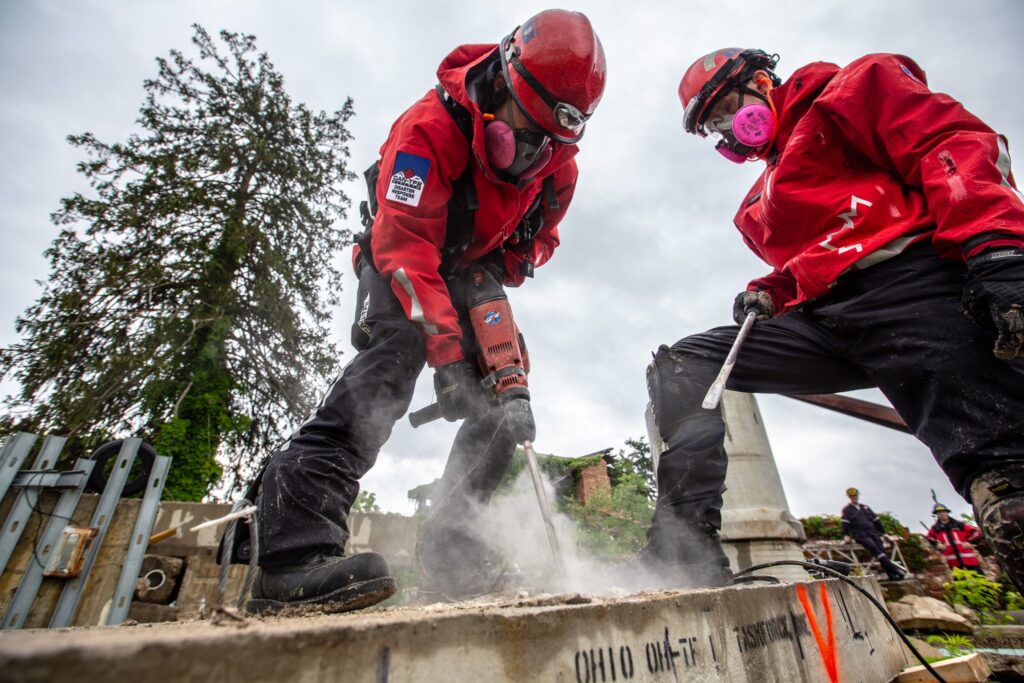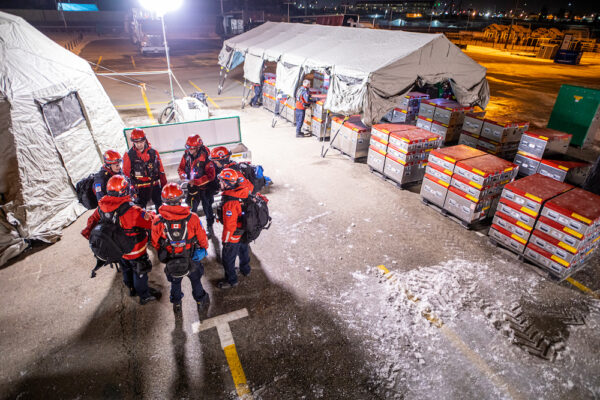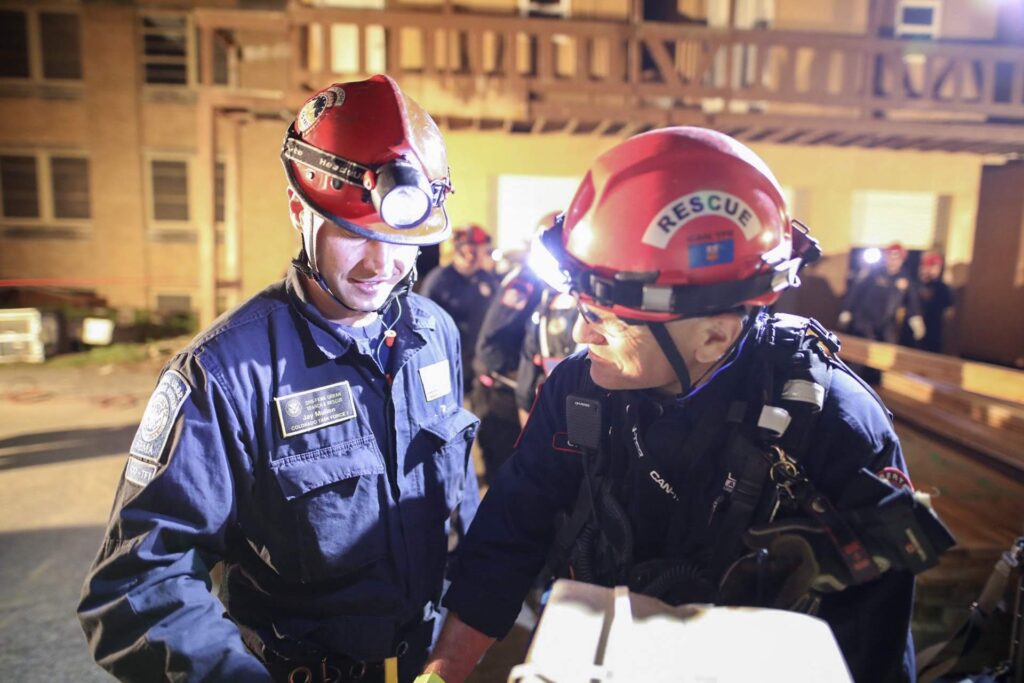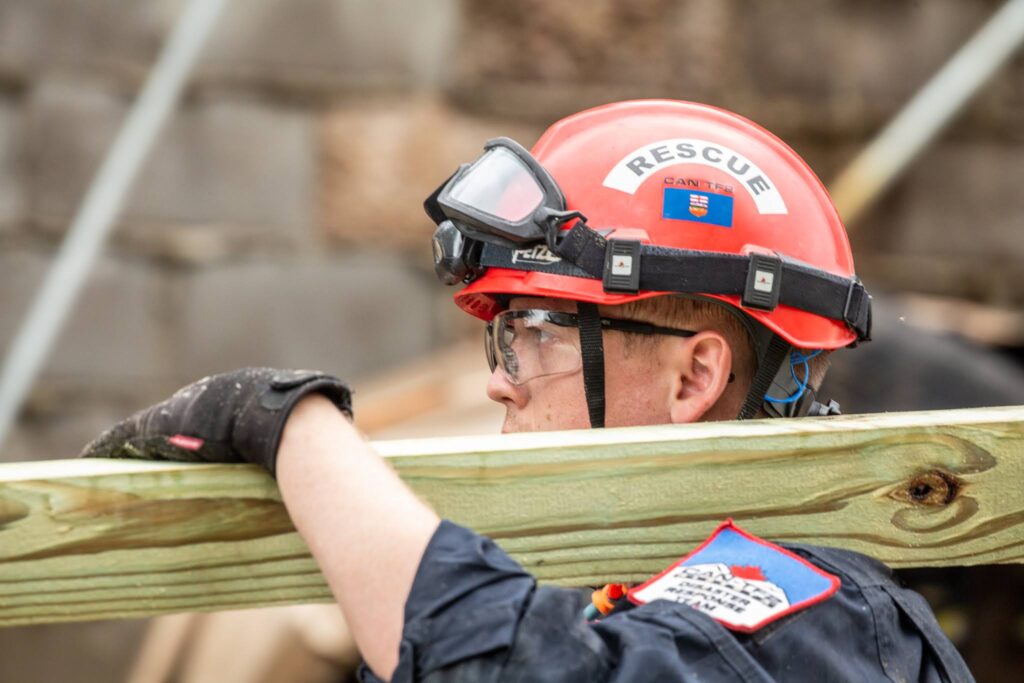
Alberta’s disaster response team is trained, equipped, and waiting for the call
November 15, 2022
By
Maria Church
Meet Canada Task Force 2, a self-sufficient all-hazards disaster response team based in Calgary that offers urban search and rescue, incident support or management, and logistics support.
 Based in Calgary, Canada Task Force 2 is one of six disaster response teams federally funded under the Heavy Urban Search and Rescue program. Photo courtesy CAN-TF2.
Based in Calgary, Canada Task Force 2 is one of six disaster response teams federally funded under the Heavy Urban Search and Rescue program. Photo courtesy CAN-TF2. Canada Task Force 2 has an awareness problem: not enough people know who they are and what they do.
One of six disaster response teams funded under the federal Heavy Urban Search and Rescue (HUSAR) program, the crew of nearly 150 members – both full-time and volunteer – based in Calgary is continually training, self-sufficient, and prepared to deploy at a moment’s notice.
But that moment isn’t up to them.
Unlike our neighbours to the south, the teams are activated at the provincial level rather than from a national co-ordinating body like FEMA. The Canadian government has a significant investment in the teams, but their activation isn’t centralized as it is in the U.S. When a large disaster strikes, the teams rely on awareness at the local jurisdiction and provincial level to be activated quickly, or at all.
CAN-TF2 co-ordinator Simon Bradley, one of four full-time members, says awareness is one of the biggest challenges facing the Canada Task Force Program.
“The teams are either relatively unknown or there are many misconceptions that may exist in what the teams are or how they operate. The Canada Task Force program doesn’t have the same household awareness as the FEMA Urban Search and Rescue teams in the United States,” he says.
While CAN-TF2 takes care of Alberta, CAN-TF1 based in Vancouver handles B.C., CAN-TF3 out of Toronto takes care of Ontario, and CAN-TF4 covers Manitoba. Halifax’s CAN-TF5, and Montreal’s CAN-TF6 are in development.
Bradley says the Calgary team, like their national partners, is modular and scalable, offering urban search and rescue, incident support or management, and logistics support, all as needed. Importantly, they are equipped to be fully self-sufficient while responding, meaning their accommodation, power generation, food and transportation are taken care of, so as not to burden the already affected area.

With around 150 members – four full-time and the rest volunteer – CAN-TF2 is continually training, self-sufficient, and prepared to deploy at a moment’s notice. Photo courtesy CAN-TF2.
As disaster events become more frequent across the country, out-of-region or inter-provincial assistance will likely become more common.
“The size and scope of disasters in Canada are pushing us beyond our traditional mutual aid boundaries,” Bradley says. A community traditionally relies on its neighbouring jurisdictions to help when their local capabilities are exceeded, but these larger-scale events require a larger, regional response.
“Personally, I don’t want the first time that someone hears about the Canada Task Force program when they are knee-deep in alligators,” he says.
Structurally unique
Part of the task forces’ awareness challenge stems from the unique way they are formed based on risk, staffing model, and home agency. CAN-TF2 is funded through all three levels of government – federal, provincial and municipal – and housed at the municipal level as part of the Calgary Emergency Management Agency. Vancouver and Toronto follow a similar model under different agencies – Vancouver Fire & Rescue Services and Toronto Fire Services.
CAN-TF4 in Manitoba, on the other hand, falls under the purview of the Manitoba Office of the Fire Commissioner – a provincial body.
Bradley says despite the different structures and team compositions, they all meet the same capabilities within the urban search and rescue (USAR) discipline: the detection, location, stabilization, and extrication of individuals in a collapsed building. Each team also has unique additional capabilities based on regional risks and hazards. For CAN-TF2 in Calgary, that includes an incident management team (IMT) capability that has been utilized in wildfires and floods.

CAN-TF2 offers three main services: urban search and rescue, incident support or incident management, and logistics support. Photo courtesy CAN-TF2.
Pillars of support
CAN-TF2 offers three main services for requesting jurisdictions: urban search and rescue, incident support or incident management, and logistics support. “These capabilities can be all concurrently utilized on a significant event or can be utilized independently for smaller or regional events,” Bradley says.
The team was most recently deployed to the Yukon in 2021 during a flooding event. Their IMT worked alongside local responders, Yukon Wildfire Management, Yukon Emergency Measures Organization, and the Canadian Armed Forces. The team helped in the co-ordination of an extensive sandbag berm system to protect homes in the Southern Lakes Region.
Other major deployments have included the Fort McMurray, Alta., ice jam in 2020, the 2019 Chuckegg Creek Wildfire in High Level, Alta., the Saint John, N.B., flooding in 2018, Fort McMurray’s 2016 interface fire, and what’s fondly remembered as “Snowtember” in Calgary in 2014.
As with all the HUSAR teams in Canada, the overseeing provincial emergency management office or agency deploys CAN-TF2. Any inter-provincial requests for assistance are co-ordinated at the provincial level.
Between deployments, CAN-TF2 keeps busy maintaining readiness and training, Bradley says. “The team is constantly training whether it be structural collapse rescue, high angle rescue, ICS position specific courses, or equipment familiarization. We work to ensure there is not just a theoretical understanding of these skills, but that a high-fidelity simulation and exercise program is a priority,” he says.
To get boots on the ground, the Calgary team takes part in large regional, national, and international exercises. They recently travelled to Indiana to participate in FEMA’s “Shaken Fury” exercise involving Canadian, FEMA, U.S. State and Australian USAR teams as well as the U.S. Air National Guard.

The Calgary team takes part in large regional, national, and international exercises. Photo courtesy CAN-TF2.
Improving effectiveness
Work recently began at the national level to evolve the Canada Task Force Program. Bradley says their focus is implementing a national governance structure.
“The teams are currently working through the implementation of an external accreditation model utilizing methodology developed through the United Nations International Search and Rescue Advisory Group (INSARAG). While INSARAG methodology has been developed for co-ordination of large international earthquake responses, this application takes the experience of the international response community and allows up to apply those structures to our domestic capability within Canada,” he says.
A revised governance structure would also help to overcome the challenge of inter-provincial reciprocity for provincially regulated professions such as paramedics, physicians, and engineers, for example. This would ensure that these responders in a different province are properly licensed and protected in the receiving jurisdiction.
The program’s evolution would, ideally, include greater cross-country awareness. As with all facets of disaster management, it all boils down to “relationship management,” Bradley says.
“We have to continue to work to build these relationships ahead of time, raising awareness beyond just our local and regional jurisdictions, to all levels of government so they are aware these teams are there and ready to help,” he says.
Print this page